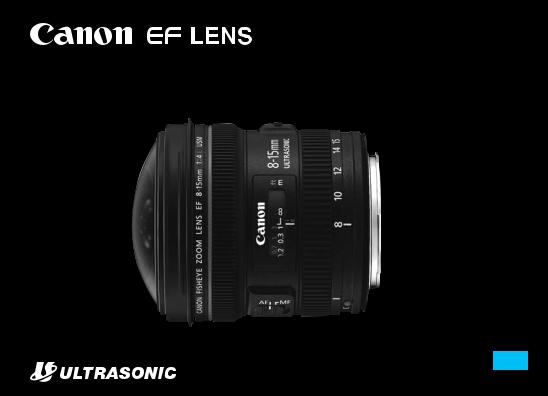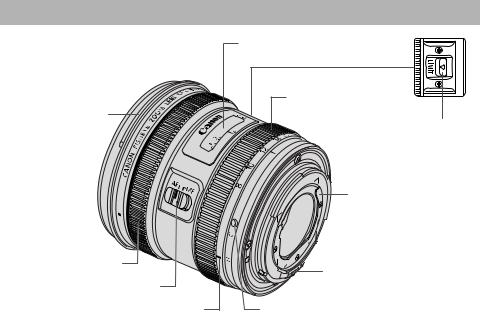Canon EF8-15 User Manual

EF8-15mm f/4L Fisheye USM
ENG
Instruction

Thank you for purchasing a Canon product.
The Canon EF8-15mm f/4L Fisheye USM lens is a high-performance fisheye zoom lens designed for use with Canon EOS cameras.
Features
1.Designed for use with three different image sensor sizes.
2.Aspherical and UD lens elements result in outstanding image delineation.
3.SWC (Subwavelength Structure Coating) is utilized to significantly reduce occurrences of flare and ghost created by quite large incident angles of light.
4.A fluorine coating has been applied to the lens’s front and rear lens elements which allows dust to be wiped from the outside of the lens more easily compared with previous lenses.
5.Ultrasonic motor (USM) for quick and quiet autofocusing.
6.Manual focusing is available after the subject comes into focus in autofocus mode (ONE SHOT AF).
7.A truly round aperture hole results in a nicer background blur.
8.Equipped with a zoom limiter function which restricts the zoom range.
9.Tight seal structure ensures excellent dustproof and drip-proof performance.
• "USM" stands for Ultrasonic Motor.
Conventions used in this instruction
Warning to prevent lens or camera malfunction or damage.
Supplementary notes on using the lens and taking pictures.
ENG-1

a Safety Precautions
a Safety Precautions
•Do not look at the sun or a bright light source through the lens or camera. Doing so could result in loss of vision. Looking at the sun directly through the lens is especially hazardous.
•Whether it is attached to the camera or not, do not leave the lens under the sun without the lens cap attached. This is to prevent the lens from concentrating the sun’s rays, which could cause a fire.
Handling Cautions
•If the lens is taken from a cold environment into a warm one, condensation may develop on the lens surface and internal parts. To prevent condensation in this case, first put the lens into an airtight plastic bag before taking it from a cold to warm environment. Then take out the lens after it has warmed gradually. Do the same when taking the lens from a warm environment into a cold one.
•Do not leave the lens in excessive heat such as in a car in direct sunlight. High temperatures can cause the lens to malfunction.
This device complies with Part 15 of the FCC Rules. Operation is subject to the following two conditions: (1) This device may not cause harmful interference, and (2) this device must accept any interference received, including interference that may cause undesired operation.
Do not make any changes or modifications to the equipment unless otherwise specified in the instructions. If such changes or modifications should be made, you could be required to stop operation of the equipment.
This equipment has been tested and found to comply with the limits for a class B digital device, pursuant to part 15 of the FCC Rules. These limits are designed to provide reasonable protection against harmful interference in a residential installation. This equipment generates, uses and can radiate radio frequency energy and, if not installed and used in accordance with the instructions, may cause harmful interference to radio communications.
However, there is no guarantee that interference will not occur in a particular installation. If this equipment does cause harmful interference to radio or television reception, which can be determined by turning the equipment off and on, the user is encouraged to try to correct the interference by one or more of the following measures:
•Reorient or relocate the receiving antenna.
•Increase the separation between the equipment and receiver.
•Consult the dealer or an experienced radio/TV technician for help.
This Class B digital apparatus complies with Canadian ICES-003.
ENG-2

Precautions for Shooting with a Fisheye Lens
•If dirt or dust adheres to the surface of the front lens element, it can easily appear in images due to the lens’s short focal length. In order to avoid this, please remove dirt or dust from the surface of the front lens element by using a commercially available air dust blower.
•Since this lens has an extremely wide angle of view, light from bright light sources, such as the sun, can easily enter the image area. Please do not look at bright light sources using the camera’s viewfinder.
•Depending on shooting conditions, flare and ghost will occur when bright light sources appear in the image area. In order to prevent flare and ghost, we suggest shooting places such as shaded areas so that bright light does not enter the lens.
•Unintentional photographing of the user’s body can easily occur during handheld shooting. Likewise, the legs of a tripod can be unintentionally photographed when a tripod is used.
In addition, due to the optical characteristics of this lens, unintentional photographing of objects can easily occur since the angle of view exceeds 180° in the close-up shooting range. Therefore, please use the camera’s viewfinder or LCD display to carefully check the image area.
•Since this is an interchangeable lens, the center of the image circle of the circular fisheye and the center of the image sensor are out of alignment. Also, there are times when vignetting, which occurs in the four corners of an image, is not uniform.
•It is possible to use AE (Auto Exposure) even if vignetting occurs in the four corners of an image when using a circular fisheye effect, etc. However, since the angle of view is extremely wide and the luminance range of subjects is broad, we suggest changing the exposure manually when possible.
Also, it is recommended that users check the image area using the LCD display when shooting with a digital camera.
ENG-3

Nomenclature
Distance scale (→ 9)
Zoom ring (→ 6)
Hood mount (→ 10)
Zoom Limiter (→ 7)
Gelatin filter holder (→ 12)
Focusing ring (→ 6) |
Contacts (→ 5) |
|
|
Focus mode switch (→ 6) |
|
“C” / “H” Indicator (→ 7) |
Lens mount index (→ 5) |
For detailed information, reference page numbers are provided in parentheses (→ **).
ENG-4
